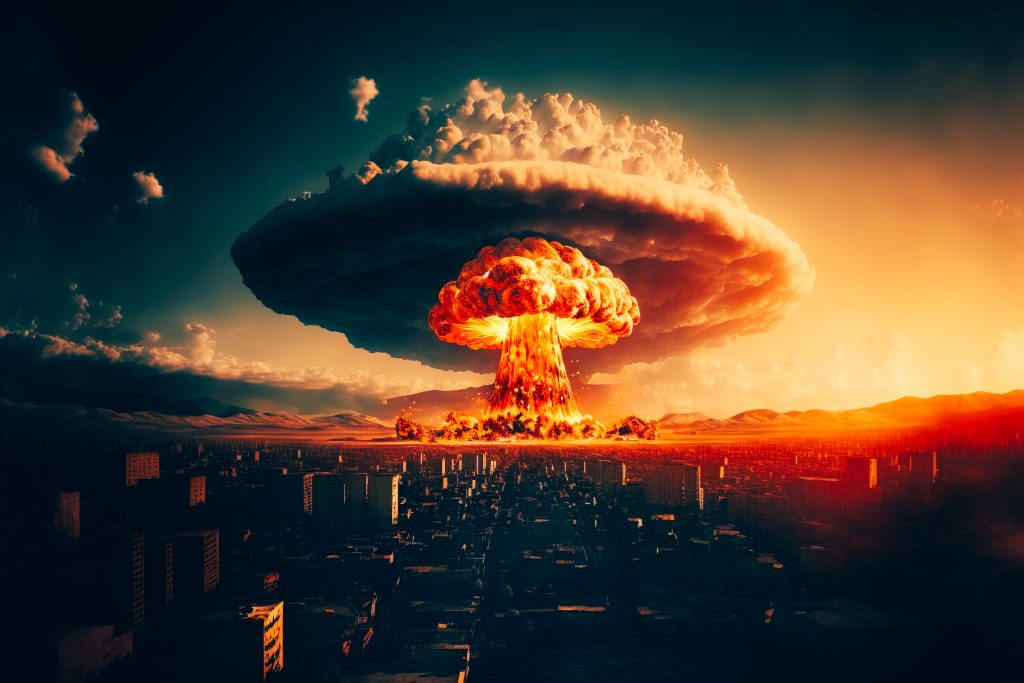Curiosity has undoubtedly led you to ponder the inner workings of atomic bombs and the source of their immense power. But have you ever wondered whether these devastating weapons utilize fission or fusion? The answer to this question lies at the heart of understanding the science behind atomic bombs. By exploring the fundamental principles of nuclear physics and unraveling the mysteries surrounding fission and fusion, we can begin to shed light on the secrets behind the destructive capabilities of these weapons. So, prepare yourself for a journey of scientific exploration as we uncover the truth behind whether atomic bombs rely on fission or fusion, and the implications of this distinction.
Basics of Fission and Fusion
Fission and fusion are two fundamental processes in nuclear physics that involve the release of energy by manipulating the nucleus of an atom. Nuclear reactions, specifically fission and fusion, play crucial roles in the development and functioning of nuclear weapons. Isotopes, such as uranium-235 and plutonium-239, are pivotal in nuclear weapons because only certain isotopes can undergo fission. The physics behind nuclear explosions relies on the chain reaction caused by the splitting of atomic nuclei, releasing vast amounts of energy.
However, the production of nuclear fuel poses significant challenges. The enrichment process is necessary to separate usable uranium isotopes, which is a complex and resource-intensive task. Additionally, plutonium is produced as a byproduct in reactors, but its separation involves highly radioactive processes. The scarcity of uranium and the difficulties associated with its enrichment further complicate nuclear fuel production.
Nevertheless, there is potential for nuclear disarmament. Efforts have been made to reduce the total number of warheads through international agreements and treaties. The goal of nuclear disarmament is to eliminate nuclear weapons entirely, promoting global peace and security. Achieving this goal would require cooperation and commitment from nuclear-armed nations.
How Nuclear Weapons Work
To understand the mechanics behind nuclear weapons, it is crucial to delve into the process by which these devastating weapons work. Nuclear weapons rely on nuclear chain reactions to generate an explosive release of energy. The role of chemical explosives is paramount in this process. Chemical explosives are used to compress the nuclear fuel, which initiates the chain reaction. In fusion weapons, the energy from the fission explosion is harnessed to trigger fusion reactions, where lightweight nuclei fuse together, releasing even more energy.
The design of nuclear weapons involves both fission spark plugs and primary and secondary components. Fission spark plugs are designed to initiate the fission chain reaction, which releases a large amount of energy. The primary component consists of the fission fuel, which is compressed by chemical explosives. The secondary component contains the fusion fuel and the fission spark plug. When the fusion fuel is triggered by the energy released from the fission explosion, it undergoes fusion reactions, which result in an even greater release of energy.
Warheads: Components and Mechanisms
Warheads, the explosive components of nuclear weapons, are composed of various components and mechanisms that work together to unleash immense destructive power. Here are four key aspects of warhead design:
- Warhead design: Warheads are meticulously designed to maximize the efficiency of the nuclear explosion. They consist of a primary stage and a secondary stage. The primary stage initiates the explosion through fission, while the secondary stage enhances the explosive yield through fusion reactions.
- Boosting mechanisms: To increase the power of the explosion, warheads incorporate boosting mechanisms. These mechanisms use the energy released from the fission reaction to compress and heat the fusion fuel, enabling a more efficient fusion reaction and a larger explosion.
- Neutron bomb technology: Some warheads are designed specifically to maximize the release of neutron radiation. Neutron bombs, also known as enhanced radiation weapons, are intended to cause minimal blast and thermal damage but produce a significant amount of neutron radiation, which can be lethal to living organisms.
- Nuclear weapon delivery systems: Warheads are integrated into various delivery systems, including ballistic missiles, bombers, and submarines. These systems ensure accurate targeting and effective deployment of the nuclear weapon.
While warheads are indeed devastating, safety measures and nuclear disarmament efforts are crucial. Strict protocols are in place to ensure the safety and security of nuclear weapons, minimizing the risk of accidental detonation. Additionally, international efforts to reduce and eliminate nuclear weapons aim to create a safer world for all.
Nuclear Fuel: Types and Production
Nuclear fuel plays a crucial role in the production of nuclear energy and the functioning of nuclear weapons. It is important to understand the types of nuclear fuel used and how they are produced. The two main sources of nuclear fuel for weapons are uranium-235 and plutonium-239. Uranium-235 is found in small amounts and requires a process called uranium enrichment to separate the usable isotope from other isotopes. Plutonium-239, on the other hand, is produced as a byproduct in nuclear reactors through a process called plutonium separation.
To better understand the production of nuclear fuel, consider the following table:
| Nuclear Fuel Sources | Production Process |
|---|---|
| Uranium-235 | Uranium Enrichment |
| Plutonium-239 | Plutonium Separation |
The fission process in nuclear reactors generates fission byproducts, including plutonium-239, which can be separated and used as fuel. However, it is important to note that the processes involved in plutonium separation are highly radioactive and require careful handling.
Additionally, nuclear reactors produce nuclear reactor waste, which consists of spent fuel rods and other radioactive materials. Proper management and disposal of this waste is crucial to ensure the safety of the environment and human health.
Countries With Nuclear Weapons
Countries that possess nuclear weapons have the potential for immense destructive power. Here are four key points regarding countries with nuclear weapons:
- Nuclear weapons stockpiles: Countries like the United States and Russia have amassed significant stockpiles of nuclear weapons. These arsenals consist of warheads of varying yields, capable of causing catastrophic damage.
- North Korea’s nuclear capabilities: North Korea’s nuclear program has raised concerns globally. While the exact extent of their nuclear capabilities is uncertain, they have conducted several nuclear tests and claimed to have developed miniaturized warheads. This has led to heightened tensions in the region.
- Israel’s nuclear program: Israel has never officially acknowledged its nuclear capabilities, but it is widely believed to possess nuclear weapons. This ambiguity has created a delicate balance in the Middle East, with neighboring countries closely monitoring the situation.
- Nuclear disarmament efforts: Efforts to reduce the total number of nuclear weapons globally have been ongoing. Treaties such as the Treaty on the Non-Proliferation of Nuclear Weapons aim to prevent the further spread of nuclear weapons and promote disarmament. However, progress in achieving complete nuclear disarmament has been slow and challenging.
It is important to closely monitor these countries and their nuclear arsenals to ensure global security and prevent the devastating consequences of nuclear warfare.
Differences Between Hydrogen and Atomic Bombs
Hydrogen bombs and atomic bombs differ significantly in terms of their destructive power and range. The comparative destruction caused by a hydrogen bomb far surpasses that of an atomic bomb. A hydrogen bomb has a reach of 5 to 10 miles, compared to the 1-mile radius of an atomic bomb. The impact on modern cities would be significantly greater with a hydrogen bomb, causing more damage to structures, infrastructure, and the surrounding area. In terms of lethality and immediate destruction, a hydrogen bomb would kill between 100 and 1,000 times more people than an atomic bomb. The aftermath and long-term effects of a hydrogen bomb would be more severe due to the higher yield of the explosion, resulting in more deaths and greater devastation. Expert opinions support these technical details, with nuclear engineering professor Edward Morse stating that hydrogen bombs have a larger reach and kill more people. The director of the University of Tennessee’s Institute for Nuclear Security describes the hydrogen bomb as a city killer. The key differences between hydrogen bombs and atomic bombs lie in their destructive power, range, and the level of devastation they can cause.
Effects and Campaign Against Nuclear Weapons
The devastating effects of nuclear weapons have motivated a global campaign against their use and proliferation. Here are four key points to consider regarding the effects and campaign against nuclear weapons:
- Effects of radiation: The use of nuclear weapons results in the release of ionizing radiation, which has severe health consequences. Exposure to radiation can cause acute effects such as radiation sickness, burns, and even death. Additionally, long-term exposure can lead to an increased risk of cancer and genetic mutations.
- Long-term consequences: The aftermath of a nuclear explosion includes not only immediate destruction but also long-lasting environmental and health effects. Radioactive fallout can contaminate the air, water, and soil, leading to ongoing health risks for both humans and the ecosystem. The consequences of a nuclear detonation can persist for generations.
- Global disarmament efforts: Recognizing the catastrophic impact of nuclear weapons, there have been significant efforts to promote global disarmament. International treaties, such as the Treaty on the Non-Proliferation of Nuclear Weapons (NPT) and the Comprehensive Nuclear-Test-Ban Treaty (CTBT), aim to prevent the spread of nuclear weapons and promote disarmament.
- Public awareness campaigns and nuclear safety measures: Various organizations and advocacy groups have launched public awareness campaigns to educate the public about the dangers of nuclear weapons. These campaigns highlight the need for strict safety measures to prevent accidents and ensure the secure storage and handling of nuclear materials. Improving nuclear safety is crucial to minimizing the risks associated with nuclear weapons.





